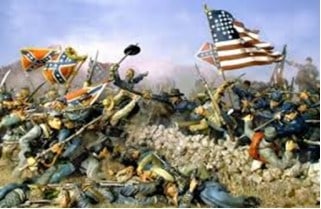The Red Badge of Courage (published 1895) by Stephen Crane is an American Civil War novel, recognised as one of the best novels ever written about war and famous for its realistic battle sequences. Even Hemmingway said that Crane was a great inspiration for him. Yet Crane was born after the American Civil War; and even more startling, he had never set foot on a battlefield. So how did he accomplish this feat?
There are obviously many reasons, many literary techniques that he employs, but one technique in particular is worthy of study: personification. It is evident throughout the entire novel. The battlefield, elements of nature (indeed, nature herself), and all kinds of instruments of battle, such as bullets and artillery shells, are rendered as living, breathing entities.
First, the Union army is seen as a living, breathing entity, for example: ‘The army awakened, and began to tremble … It cast its eyes upon the roads.’ The campfires of the army are likened to the eyes of this living thing: ‘One could see … the red, eyelike gleam of hostile camp-fires set in the low brows of distant hills.’
Next, instruments of war are imbued with human properties, even bullets which ‘began to whistle among the branches and nip at the trees.’ These ‘crackling shots … were to [the soldier] like voices’ and ‘spiteful sentences’.
Artillery pieces are portrayed as real, living things, and not mere objects on the battlefield. Even before they began firing, ‘the artillery were assembling as if for a conference.’ Then the ‘batteries were speaking’ and ‘the guns, stolid and undaunted, spoke’ with ‘courageous words’ and ‘the cannon with their noses … grumbled like stout men’. The cannon had ‘entered the dispute’ as if they were angry people wanting to be heard, as ‘their voices made a thudding sound’ and ‘the guns were roaring without an instant’s pause for breath.’ Even the artillery shells are personified: ‘They hurtled over [the soldier’s] head with long wild screams. As he listened he imagined them to have rows of cruel teeth that grinned at him.’
Turning to the battle flag, it lives, breaths, and has emotion: ‘The battle flag in the distance jerked about madly. It seemed to be struggling to free itself from an agony … The flag suddenly sank down as if dying. Its motion as it fell was a gesture of despair.’
Finally, there are the drums and bugles which ‘sing’ and ‘call to each other’.
Next, personification is evident in nature. To the narrator, nature herself is perceived ‘to be a woman with a deep aversion to tragedy.’
The forest is alive; trees and vines seem to experience pain and inner turmoil. For instance, ‘[t]he creepers, catching against his legs, cried out harshly as their sprays were torn from the barks of trees.’ Moreover, ‘prominent trees spoke to [the soldier] of tragedies—hidden, mysterious, solemn.’
Furthermore, trees are shown to be acting like people, for example, ‘[t]he trees hushed and stood motionless [and] seemed to be listening.’ Also, ‘trees and vines … waved their arms and turned their face leaves toward [the soldier].’ Even the branches ‘threatened’ the soldier; and when not threatening ‘the trees began softly to sing a hymn of twilight.’ There is a further reference to the ‘chanted chorus of the trees’.
The trees seem to be warning the soldier, as in this passage: ‘Trees, confronting him, stretched out their arms and forbade him to pass … It seemed that Nature could not be quite ready to kill him.’
Finally with nature, a river is seen as something alive, with a sombre feeling. For example: ‘The mournful current moved slowly on, and from the water, shaded black, some white bubble eyes looked at the men.’
Next, the battlefield comes alive. ‘This landscape … would die if its timid eyes were compelled to see blood.’ Even a farmhouse after the battle appears ‘calm’, and a ‘little narrow roadway now lay lifeless.’
All in all, personification is dominant in the novel, rendering nature, instruments of war, the army, and the battlefield itself as living, breathing entities. One technique among many, personification brings the war scenes to life and creates a sorrowful, haunting, and often grisly picture of warfare that is forever implanted in the reader’s mind.
About The Author
Patrick Martin Andrews was born in Milton, New Zealand, and educated at the University of Otago, Dunedin, and Murdoch University, Perth. He has worked as a deep-sea diver, journalist and English teacher.



















